Why the war in Ukraine will cost the global economy a “hefty price”
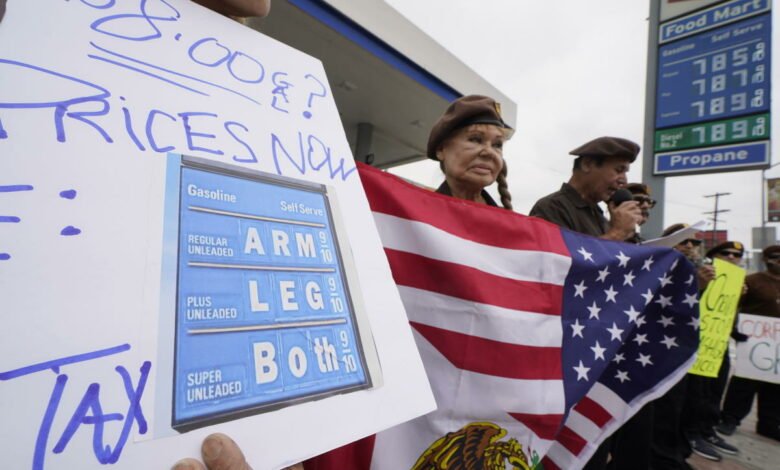
According to the OECD, the war in Ukraine would cost the global economy a “hefty price” in terms of weaker GDP, higher inflation, and perhaps long-term damage to supply networks.
According to forecasts presented on Wednesday in Paris, the group lowered its global growth forecast for this year to 3% from 4.5 percent in December and quadrupled its inflation forecast for its 38 member countries to over 9%. It predicts growth to fall to 2.8 percent in 2023.
It cautioned that the cost of war might be “much higher,” citing a long list of threats ranging from an unexpected cut-off of Russian supply in Europe to financial market vulnerabilities caused by high debt and rising asset prices.
In its economic assessment, the group stated, “There have been numerous notable changes in the global economic situation in recent months, including the worldwide distribution of the Omicron form of Covid-19 and the greater-than-expected endurance of inflationary pressures.”
“However, the economic consequence of the war in Ukraine is the single most significant change.”
The grim assessment, which mirrors a similar warning from the World Bank, suggests that Russia’s invasion would have a deeper and broader economic impact, making it more difficult to implement the correct fiscal and monetary policies.
The early effects of rising prices have already led central banks to tighten monetary policy, with the US Federal Reserve raising interest rates 50 basis points faster than expected last month. In the meantime, governments are revising their spending plans in an effort to protect households.
While the OECD believes that all monetary authorities should reduce stimulus, it advises prudence, particularly in the eurozone, where rising prices are mostly due to supply pressures.
“Central banks will have to make a tough balance between maintaining price stability and assisting the post-pandemic economic recovery,” the statement stated.
Speaking to reporters in Paris, Chief Economist Laurence Boone stated that disruptions to the global economy might have a long-term impact on investment.
“We’ve had a series of shocks, from the plague to the war,” she added, “and the supply side of the economy in some countries hasn’t fully recovered.” “The longer this goes on, the more global supply networks will be disrupted, and investors will be less likely to invest.”
Inflation is affecting living standards and cutting consumer spending around the world, according to the OECD, and businesses are becoming less hopeful about future production. Importantly, the loss of confidence is inhibiting investment, which threatens to harm supply “for years to come,” according to the report.
Despite similarities to the oil shock of the 1970s, the organization is skeptical about whether the world economy is on the verge of stagflation.
Major economies are less energy-intensive now than they were before, central banks have more robust frameworks and independence, and consumers have a store of extra funds from the Covid-19 epidemic, according to the report.
The OECD stated, ” but there might be a serious risk that GDP may fall faster than expected escalating inflationary pressures. In May, US inflation hit a new 40-year high, showing that pricing pressures are becoming entrenched in the economy and eroding consumer confidence. For more information, visit https://en.wikipedia.org/wiki/Russo-Ukrainian_War
As they seek to resist unrelenting inflationary pressures, more central banks around the world are unleashing a greater amount of policy firepower.
- World: India and Australia both raised interest rates by a half-point this week, joining a group of more than 50 central banks that have increased borrowing costs by at least a half-point this year. Chile, Poland, and Peru, who were already members of the group, hiked again. Meanwhile, Russia reversed course, dropping rates to levels seen prior to the invasion of Ukraine.
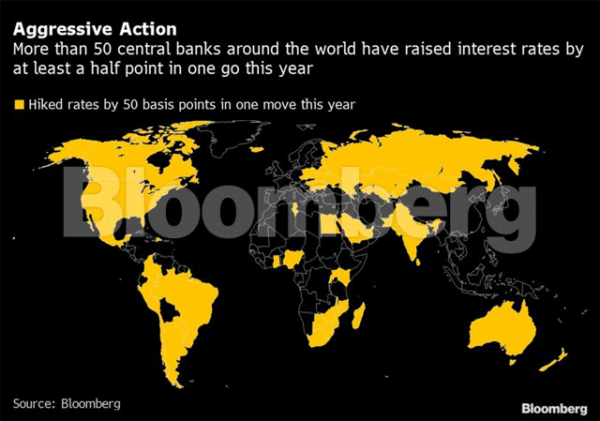
According to the OECD, the war in Ukraine would cost the global economy a “hefty price” in terms of weaker GDP, higher inflation, and perhaps long-term damage to supply networks. The group lowered its global growth forecast for this year to 3%, down from 4.5 percent in December, and increased its inflation forecast for its 38 member countries to roughly 9%. It predicts growth to fall to 2.8 percent in 2023.
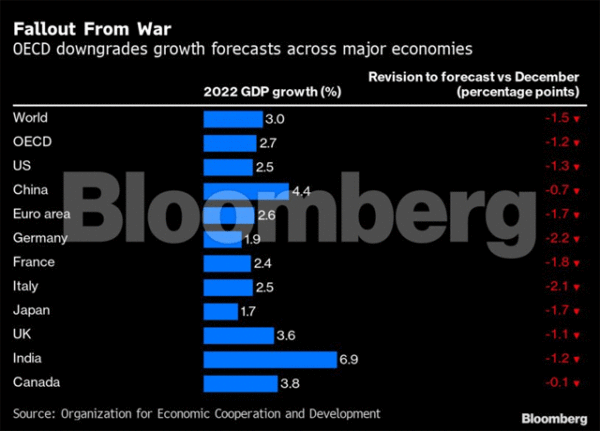
Three of the primary supply-side variables driving today’s global inflation levels have already reversed, indicating that shoppers throughout the world may be in for some respite.
- US: Inflation in the United States increased to a new 40-year high in May, signaling that pricing pressures are becoming entrenched in the economy and eroding consumer confidence. The Federal Reserve is expected to extend an aggressive run of interest-rate hikes into the fall, based on the latest government inflation numbers.
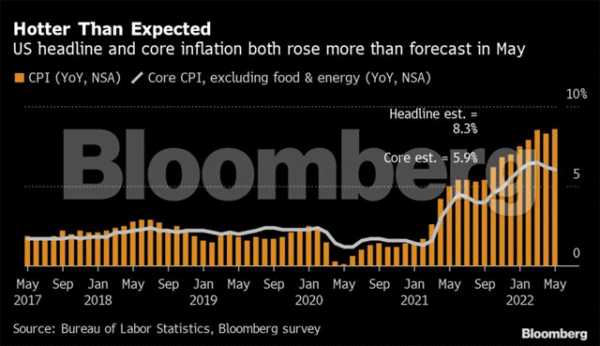
The Port of Los Angeles expects inbound container volumes to reach year-ago levels for the first time in two months. It’s too early to tell whether this is a one-off or the beginnings of a larger influx of commodities from Asia, but these figures will be constantly monitored as the busiest US trade turnstile approaches crunch time.
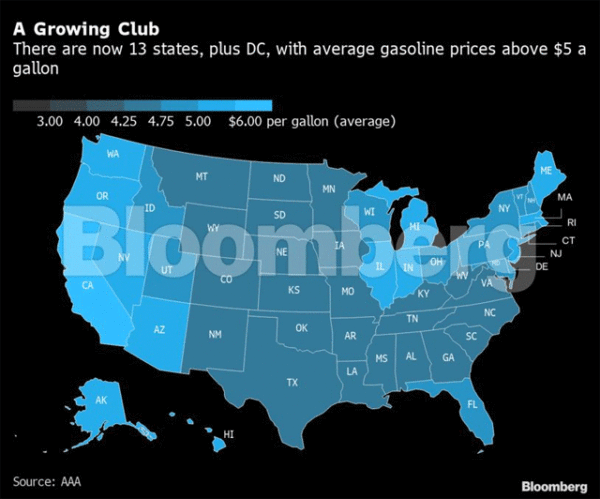
Gasoline prices have risen to $5 a gallon or higher in more than a dozen US states a week into the busy summer travel season, as fuel supplies remain scarce. JPMorgan Chase & Co.’s projection of $6.2 per gallon of gasoline by August appears to be well within reach at the current rate.
- Europe: Facing record inflation, the European Central Bank has committed to a quarter-point hike in interest rates next month and has left the door open to a larger hike in the fall. It will end large-scale asset purchases on July 1 due to new predictions indicating a faster path for euro-zone prices than previously assumed.
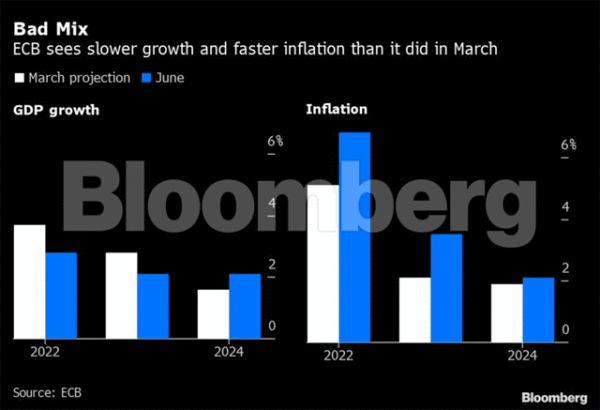
In April, German industrial orders unexpectedly fell as China’s supply chains were strained, adding to the interruptions caused by Russia’s invasion of Ukraine.
Russian efforts to reroute trade flows and circumvent sanctions in response to the crisis in Ukraine aren’t enough to compensate for the drop in imports that is damaging the country’s economy.
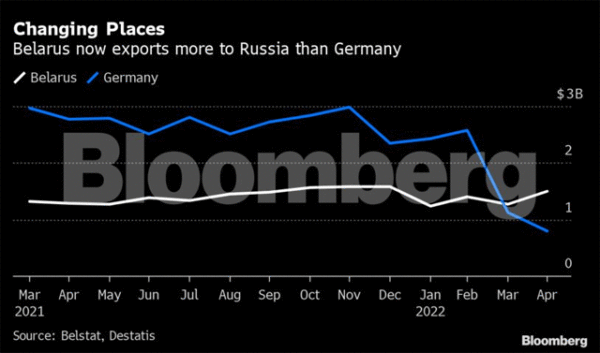
According to a Bloomberg study of the latest data, Belarus, a neighboring country that Russia exploited to help stage the invasion, overtook Germany in April for the first time – an economy more than 60 times larger by the value of imports to Russia.
- Asia: Bank of Japan Governor Haruhiko Kuroda highlighted some positive changes that suggest progress toward his stable inflation target while emphasizing that policy tightening is still not an option for the time being. The governor stated in a speech Monday that several data sets reflect increased inflation forecasts and a higher tolerance for price hikes among families.
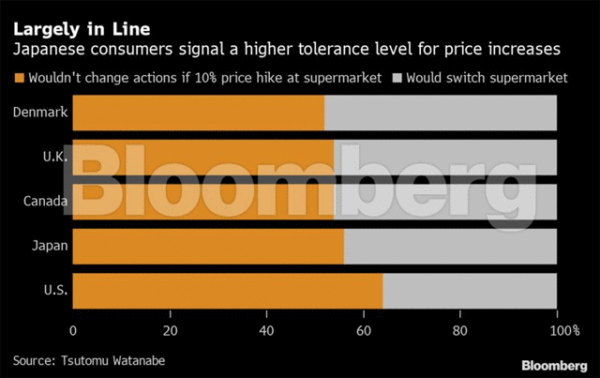
Thailand’s retail inflation accelerated in May to its highest level in nearly 14 years, putting the central bank’s resolve to keep borrowing rates unchanged to the test. Consumer prices increased 7.1 percent from a year ago, up from 4.7 percent a month ago, according to government statistics released Monday.
Emerging Markets
Before the central bank meets to discuss extending its aggressive cycle of interest rate hikes, economists in Brazil have raised their inflation estimates for this year and next. According to a central bank survey released on Monday, consumer prices will rise 8.89 percent in December, exceeding the previous projection of 7.89 percent from May 2.
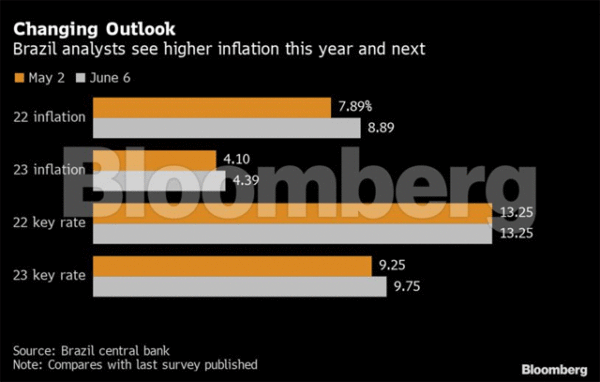
The OECD predicts reduced global growth as a result of the ‘heavy price’ paid by the Ukraine war:
The OECD warned on Wednesday that Russia’s invasion of Ukraine would cost the global economy a “hefty price,” slashing its growth prediction for 2022 and forecasting greater inflation.
The Paris-based organization, which represents 38 primarily industrialized countries, is the latest to forecast reduced GDP growth as a result of the conflict, which has pushed up food and oil prices.
The OECD warned on Wednesday that Russia’s invasion of Ukraine would cost the global economy a “hefty price,” slashing its growth prediction for 2022 and forecasting greater inflation.
The forecast for 2022-23 had been “broadly favorable” before the conflict broke out, with growth and inflation projected to recover to normal following the disastrous Covid-19 outbreak, according to the OECD.
“However, the invasion of Ukraine, as well as shutdowns in major Chinese cities and ports as a result of China’s zero-Covid-19 policy, has sparked a fresh set of unpleasant shocks,” according to the research.
Food shortage risk: The OECD intended to release its outlook in March, but because of the war’s uncertainties, it postponed it until now. It said at the time that the conflict may reduce global GDP growth by “nearly 1%.”
On Tuesday, the World Bank reduced its own projections, cutting its global growth forecast from 4.1 percent to 2.9 percent. In April, the IMF lowered its prediction by roughly one percentage point to 3.6 percent.
The OECD lowered its growth forecasts for the United States and China, the world’s second-largest economy, from 3.7 percent to 2.5 percent and 4.4 percent, respectively. The euro zone’s GDP is now expected to increase at 2.6 percent rather than 4.3 percent, while the UK’s growth forecast has been slashed to 3.6 percent from 4.7 percent.
Commodity prices had risen, affecting real income and spending, according to the OECD”, especially for the most vulnerable households.”
“Food shortages are a serious threat in many emerging-market countries, given their reliance on agricultural exports from Russia and Ukraine.” it was stated
The research warned that the “effects of the war in Ukraine may be even bigger than envisaged,” citing a scenario in which Russia cuts gas supply to Europe as an example.
According to the paper, if central banks tighten their monetary policies to combat inflation, rapid increases in interest rates could hurt the economy more than expected.
Covid-19 risk: Meanwhile, the Covid-19 pandemic may take a turn for the worse.
According to the OECD, “new, more aggressive or infectious forms may arise.” “While zero-Covid-19 policies in large countries like China have the potential to stifle global demand and disrupt supply for a period of time.
In the face of these concerns, governments must protect the most vulnerable from economic shockwaves, according to the report.
The poorest households would benefit from “temporary, timely, and well-targeted” fiscal measures in the short term, according to the OECD.
Governments would have to invest more in clean energy and defense spending in the medium and long run.
“The world has already paid a high price for Russia’s aggression,” Boone wrote.
“How that price is distributed across people and countries will be determined by political and citizen actions.”
The following are some more highlights from the report:
- Europe is one of the most vulnerable regions if the conflict in Ukraine continues or escalates, as its economy struggles to wean itself off Russian fuel.
- Increasing prices of basic food and energy are also putting low-income economies in danger.
- Increases in interest rates could stifle GDP more than anticipated.
- China’s Covid-19 Zero policy continues to have a negative impact on the global economy.
Some of the OECD’s proposals are as follows:
- To avoid a food crisis, more aid and worldwide logistics cooperation are needed.
- Government assistance is targeted at households most affected by growing living costs.
- Central banks have sent out signals that they will not allow inflation to spread.
- As prices are driven by overly strong demand, the US monetary policy can tighten faster.
- Europe needs to be more united when it comes to defense and energy spending.
- To ensure a varied value chain for the green transition, keep commerce open.
Read more details on the Inventiva Website – https://www.inventiva.co.in/
Also, visit https://www.inventiva.co.in/trends/russia-ukraine-crisis-and-its-impact-on-india/to know more about the Russia-Ukraine Crisis and its impacts.



